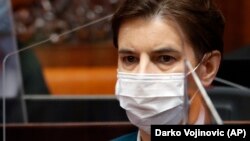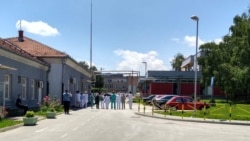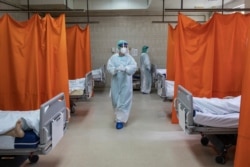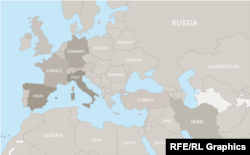Prime Minister Ana Brnabic is continuing a public offensive to reassure Serbs that their government has the new coronavirus "totally under control" following a bruising week of spiking infections and an accusation that her government was wildly underreporting COVID-19 deaths and infection rates ahead of June 21 elections.
The prime minister came out swinging in a weekend television appearance in which she countered that Serbia's seemingly low death count -- now officially 277 -- was, in fact, overstating the number of deaths caused by the pathogen.
"Let's say I have symptoms," Brnabic hypothesized on TV Pink on June 28. "I go to the COVID clinic and I get a positive result and they enroll me in the database. I'm on my way to the Infectious Diseases Clinic and a bus hits me. In that database, I died. Do you think I should be counted as dead of COVID-19? There are X-Y such cases."
Neither Brnabic nor any other senior government officials have convincingly contradicted the claims in a recent report by the Balkan Investigative Reporting Network (BIRN) alleging that Serbia's actual COVID-19 infections and deaths are of a magnitude higher than officials are admitting.
It is an echo of disputes in harder-hit countries from China to Russia to Brazil and the United States, as the political stakes have risen with mounting death tolls and economic consequences from the coronavirus pandemic.
But the stakes were particularly high in Serbia during the 10 weeks that the BIRN report covered.
President Aleksandar Vucic ended a state of emergency on May 6, allowing for six weeks of gradual reopening before elections on June 21 that were boycotted by the opposition. Slightly over half of eligible voters turned out to give the ruling Serbian Progressive Party of Vucic and Brnabic and its partners a potential "supermajority" in the national parliament.
A surge in cases since Serbia began reopening in May and complaints from hospital workers in some areas saying they have insufficient equipment to combat the outbreak have added to public fears that hung over the voting.
"I was born in Tutin and I've lived there for 55 years, and I don't remember a situation like this, with several funerals every day. It's an indirect indicator, and I'm telling you: These people mostly die at home," Mithat Eminovic, an epidemiologist, told RFE/RL's Balkan Service. Eminovic works at a health center in Tutin, in the Sandzak region of southeastern Serbia where a fresh outbreak has infected at least 600 people.
"I don't dispute that there are other causes of death, but the vast majority [of very recent deaths] certainly have the virus. But we don't have official data, because these people didn't die in health facilities," he said.
About 35 kilometers from Tutin, in Novi Pazar, where a local state of emergency has been declared because of a spike of more than 500 infections and urgent warnings about a lack of medical supplies, a dozen or so health workers stood outside their hospital and turned their backs on Brnabic and Health Minister Zlatibor Loncar when those two arrived for a visit on June 30.
More people tried to shout down Brnabic and Loncar at their accompanying press conference, where the prime minister blamed "fake news, misinformation, and politicking" and said the situation was "totally under control."
Loncar responded to a question prompted by reports that local officials had requested tin coffins in an effort to avoid possible infections from corpses.
He repeated assurances that the procedure was just a precaution, and that tin coffins were being used in any case in which COVID-19 is even suspected.
But, Loncar said, "You can't accuse us [of underreporting figures] just because someone died at home."
Even amid the intense concerns of fresh spikes at home, Serbia got a public affirmation from abroad this week of its pandemic response.
The European Council on June 29 included Serbia on its list of 15 non-EU "safe" countries for whom it would lift restrictions on nonessential travel, based on their effectiveness controlling the coronavirus.
The council's criteria included "the reliability of the information" those countries were providing on their outbreaks.
Just one week before the European Council issued its list, on June 22, BIRN claimed it had analyzed data "obtained from the state's COVID-19 information system" that hinted at massive underreporting of infections and deaths in Serbia from the 10-week period to June.
The statistics, it said, showed that "more than twice as many infected patients have died than the authorities announced, and hundreds more people tested positive for the virus in recent days than admitted."
The BIRN report was published one day after the rescheduled elections.
Much of the political opposition boycotted the vote over Vucic's increasingly tight grip on media and state institutions, and OSCE observers cited "the opposition's lack of access to the media" and risks "to the neutrality" of Serbia's democratic institutions in their criticism of the process.
The discrediting of official statistics seemingly aimed at downplaying the outbreak could have undermined campaigning by the ruling parties to portray their handling of the epidemic as informed and effective.
The World Health Organization (WHO) guidelines on reporting cause of death describe "all those diseases, morbid conditions or injuries which either resulted in or contributed to death and the circumstances of the accident or violence which produced any such injuries."
Srdja Jankovic, an immunologist and member of the government's crisis staff to cope with the coronavirus, did not reject BIRN's statistics and acknowledged that the report warranted checking.
"I didn't see the data from that database and I don't prejudge what's true," Jankovic told a weekly current-affairs program on June 28. "The most important thing is to get to that truth as soon as possible, and it can only be reached by comparing each item of data in that database with official data."
Whether or not the BIRN report contesting Serbia's public death figures is correct, people there on average are currently at greater risk of dying of COVID-19 than in a traffic accident like the one described by Brnabic (if you exclude comorbities, age, and other underlying factors).
Serbia averaged a respectable 7.4 traffic deaths per 100,000 people in 2016, according to the most recent WHO statistics available, which is around half of neighboring Bosnia-Herzegovina to the west and two-thirds of the rates in Romania and Bulgaria to the east.
Meanwhile, the Serbian Health Ministry's website on July 1 was reporting 277 confirmed COVID-19 deaths so far in the country, or fewer than four fatalities per 100,000 inhabitants in the past four months (or 12 at an annualized rate).
BIRN put Serbia's COVID-19 death tally four weeks ago -- even before the recent surge in infections -- at 632. That would raise the rate so far of COVID-19 deaths to more than nine fatalities per 100,000 residents (or 27 at an annualized rate).
Social media lit up with takes on Brnabic's "hit-by-a-bus" remarks.
One Twitter user said her defensiveness seemed far removed from Vucic's pledges early in the outbreak of transparency in dealing with the coronavirus.
"Brnabic tried to explain why they cheated re the real covid-19 death toll. Not convincing," the user said.
Another, Bora Ristic, mocked her anecdote, too.
"Where x is the truthfulness of her statements (assumed to be 0), y is the number of times she actually thinks this has happened (also assumed to be 0)," he tweeted.
Senior Serbian officials including Vucic initially mocked the COVID-19 threat -- even taking a "solidarity" visit to China when the pathogen was raging there in late February -- before coming around to the seriousness of the pandemic as cases exploded in nearby Italy.
On March 15, Vucic imposed a state of emergency and a strict lockdown along with conspicuous fines for violators that were ended on May 6.
After a lull, it has seen a steady rise in confirmed infections over the past two weeks, jumping from under 100 a day to well over double that rate.
In the same TV appearance, Brnabic came out in defense of Novak Djokovic of Serbia after the world No. 1 tennis player’s ill-advised Balkan exhibition tour erupted in coronavirus infections earlier this month, the outrage stoked by videos of participants and the public ignoring distancing protocols on the court, at a disco, and in the stands.
“He tried to do something good for the whole region,” Brnabic said of Djokovic, stressing that she and other officials were responsible for easing anti-pandemic restrictions. “It’s my fault, not Novak Djokovic’s, and leave the man alone.”
Those who attended the events, she said, "determined their own risk."
The most populous of the so-called Western Balkans Six at 7 million people, Serbia has far outpaced other Balkan peninsula countries in confirmed coronavirus infections, although North Macedonia’s 2 million people have seen more infections per capita.
Live Map: The Spread Of The Coronavirus
But Serbia’s official figure of 277 deaths by June 20 suggests its case-fatality ratio (the percentage of confirmed cases that end in death) is less than 2 percent, second-best in the region behind Kosovo, according to Johns Hopkins University. Its official rate of COVID-19 deaths per million inhabitants is 32, less than half of the global average of 65, according to Worldometers.info.
The late June surge in infections prompted the government’s task force for the crisis to convene on June 29 to consider new restrictions.
It ordered new mandatory steps in the capital – which has around two-thirds of Serbia’s active cases – but stopped at urging the rest of the country to follow safety recommendations. It said stricter measures could be enacted in some places in the event of local flareups.
Face masks are obligatory in indoor spaces and on mass transit in Belgrade from June 30, it said, and Belgrade officials have warned that violators may be fined.















